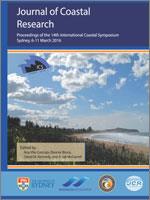Iida, T.; Kure, S.; Udo, K.; Mano, A., and Tanaka, H., 2016. Prediction of the 2011 Tohoku Tsunami scouring near structures. In: Vila-Concejo, A., Bruce, E., Kennedy, D.M., and McCarroll, R.J. (eds.), Proceedings of the 14th International Coastal Symposium (Sydney, Australia). Journal of Coastal Research, Special Issue, No. 75, pp. 872–876. Coconut Creek (Florida), ISSN 0749-0208.
The 2011 Tohoku Tsunami left innumerable sites with large scale scouring near failed coastal structures. This was a major cause of failure, and the reconstruction of these structures in a robust way requires determination of the mechanisms and prediction of the scouring. Two mechanisms are known for tsunami scouring: erosion by the bottom shear stress and liquefaction by the pore pressure, however, these mechanisms have not been compared yet in their effects. This study aims to quantify these mechanisms and predict the scouring by the 2011 Tohoku tsunami. For this approach, we developed a numerical model by the quasi-3D finite volume method by meshing horizontally in water and vertically in ground. After validating our model, we have applied it to the breach point of a coastal levee hit by the tsunami. We can conclude that erosion by the bottom shear stress has the major role, however, the fluidisation still has innegligible effect in 28% to the maximum erosion depth.





